Dan Harmon’s Story Circle Is a Modern Take on the Hero’s Journey
Article by Colette Nichol, Story Strategist, SEO Expert, and Solo Filmmaker
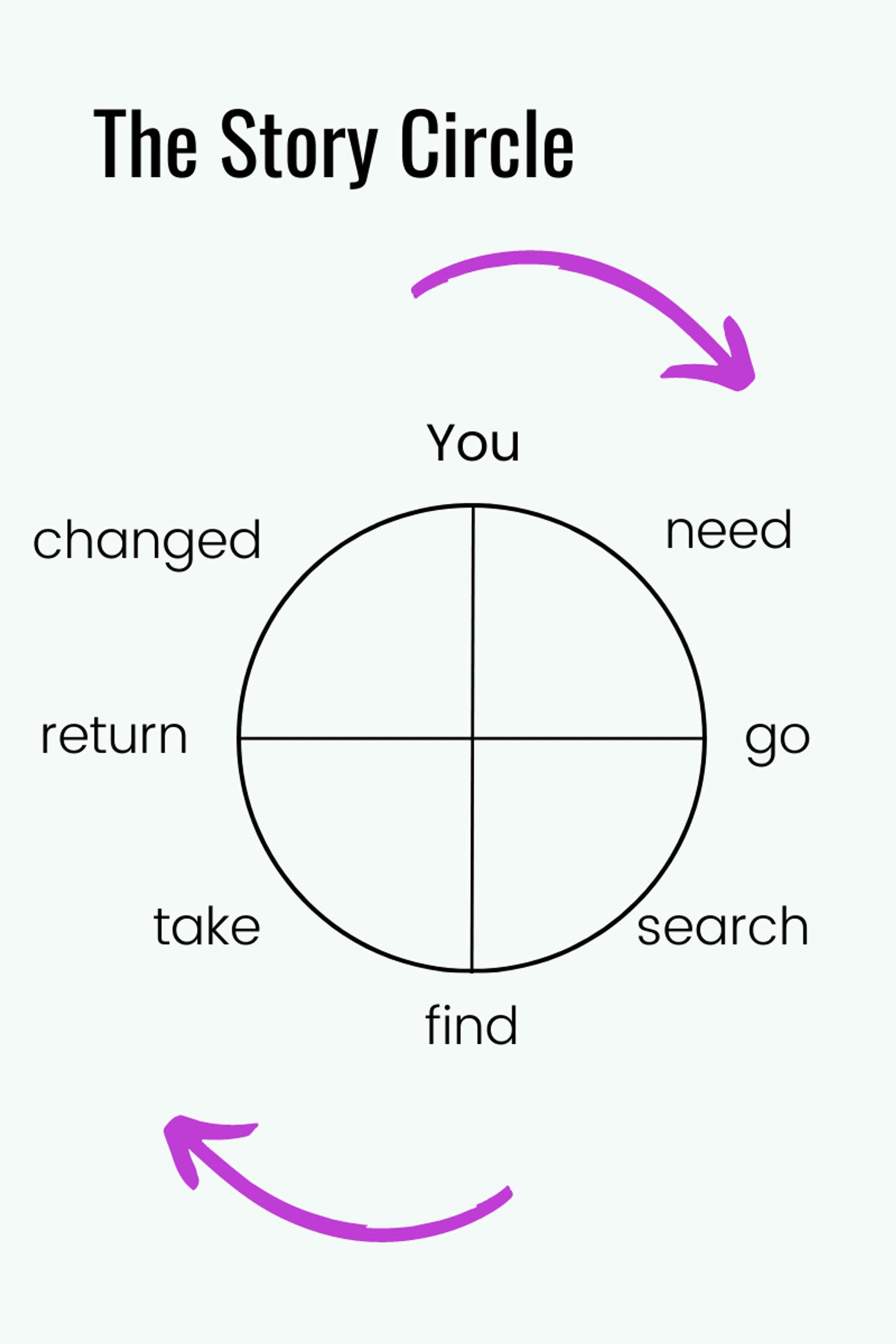
What Is Dan Harmon’s Story Circle with Examples?
The story circle is a story structure guide created by Dan Harmon based on Joseph Campbell’s analysis of the Hero’s Journey.
The story circle consists of the eight main plot points that create a story’s foundational structure, which Dan Harmon has labelled: you, need, go, search, find, take, return, changed.
- You – A character with a problem.
- Need – Has a need.
- Go – And crosses the threshold in the world of adventure.
- Search – To find the answer to their problem.
- Find – They find that things are not what they seem.
- Take – They get what they want but it was not as they expected.
- Return – They return to the ordinary world.
- Changed – And they are transformed by their journey.
For a ton of extensive examples with videos, read through this entire post where I cover each important turning point in a story in details with examples. But first, some background!
Who Is Dan Harmon?
Dan Harmon is a TV writer known for writing and creating Community.
He also co-created Rick and Morty and is credited with writing 61 episodes.
To get the juices flowing in the writer’s room and guide the writing of new episodes, he simplified the hero’s journey into eight key concepts that make it easy to assess or build a story idea quickly.
It’s brilliant. It’s simple. And dammit, it’s delicious!
I got obsessed with Dan Harmon’s story circle a few years ago, hunting down every time Harmon wrote about or spoke about his method of breaking down stories. If he talked about it on the internet, I found it and ate it up.
It’s not that Harmon is saying anything new.
But the way he’s broken down the Hero’s Journey is so practical and, frankly, beautiful that it’s worth knowing and using. If you’re a writer, storyteller, director, producer, or even business owner, you need to know how to pull apart and put together a story.
So let’s discuss and dissect this beautiful tool. Onward!

Table of Contents
- How Dan Harmon’s Story Circle Works
- Part 1: The 8 Stages of Dan Harmon’s Story Circle
- YOU, NEED: A Protagonist Needs Something
- GO: The Hero Crosses the Threshold Into the World of Adventure
- SEARCH: The Hero Is on the Road of Trials
- FIND: Reckonings, Meeting the Goddess, Vulnerability, Bliss
- TAKE: The Face Off, Meet Your Maker, Facing the Father
- RETURN: The Flight Home
- CHANGE: The Hero Is Transformed and Shares their Wisdom
- The Universal Structure of Storytelling
- Top and Bottom Half of The Story Circle
- Part 2: The World of Adventure vs. The Regular World
- Crossing the Threshold
- Part 3: Starting Value or Idea and Ending Value or Idea
- Watch: The Dan Harmon Story Circle Explained by Dan Harmon
- Common Story Circle Questions
How Dan Harmon’s Story Circle Works
First, let me be clear that I’m explaining the story circle in the way that I use it.
I’m not Dan Harmon, and I’m not trying to explain this concept verbatim. So take what you want from this analysis, and don’t hold it against me if I don’t explain this exactly the way Dan Harmon does.
That said, I’m probably the only person on the internet who has hunted down every single thing Mr. Harmon has written about the story circle, put it in a Google doc, printed it, highlighted it, and then practiced it…over and over again!
Anyway, at the end of the day, what matters is HOW you use this information, not whether it was delivered to you in some perfect authoritative package. Now, let’s get to it!
There are three main parts to the story circle:
- The 8 Stages
- The World of Adventure vs. The Regular World
- The Starting Value/Idea vs. The Ending Value/Idea
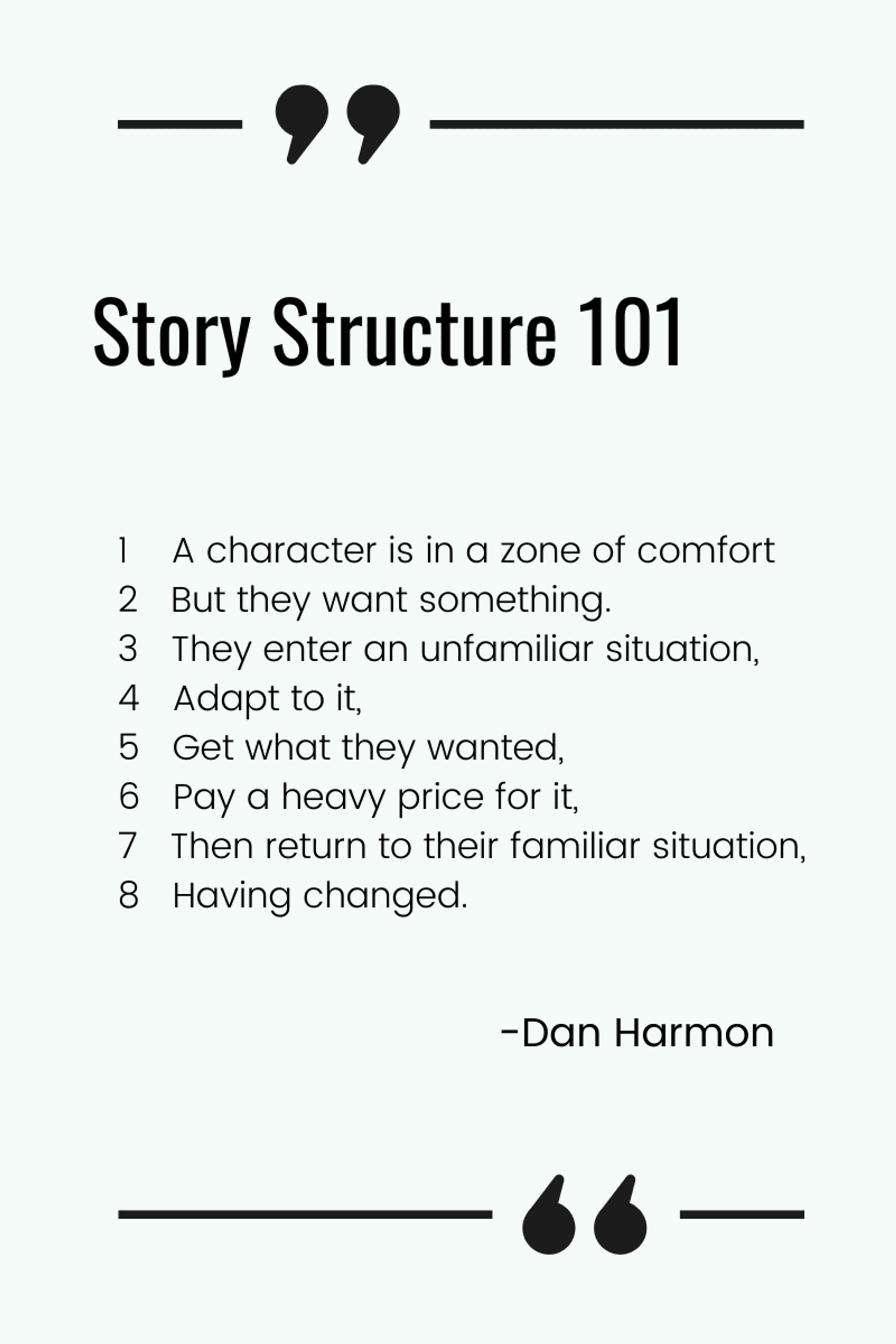
Part 1: The 8 Stages of Dan Harmon’s Story Circle
There are eight basic stages in the structure of Dan Harmon’s story circle.
It’s no different from the eight stages in the Hero’s Journey. But the way he describes these stages, with a punchy one-word descriptor, makes this tool easy to use.
- Stage 1: YOU
- Stage 2: NEED
- Stage 3: GO
- Stage 4: SEARCH
- Stage 5: FIND
- Stage 6: TAKE
- Stage 7: RETURN
- Stage 8: CHANGE
Before I describe how to interpret and use these stages, look at that list yourself. What do you think each stage means?
Think of a story in your life, and run it through those stages.

You: The Main Character Is in the Comfort Zone
Before anything crazy happens, it’s just you and your regular everyday life.
Things aren’t great. You’re dissatisfied. But you’re not willing to make massive changes. You’re just living life in a quasi-apathetic state, aka normal.
Every story needs a hero—ideally, one, not ten. Even multi-character dramas or action movies like Oceans 11 have one main character who drives the story forward.
Need: The Character Wants Something, Desire Blooms
You want something. You’re not satisfied with just the status quo. Either this desire comes internally and is there before the inciting incident. Or something or someone comes along and awakens the desire within you.
Story Circle Examples
Wizard of Oz Story Structure Example:
Dorothy is in the black-and-white world, moaning and groaning (in song) about how she’d like to be somewhere over the rainbow rather than hanging in Kansas. She needs something to happen so she can escape from her humdrum lands.
Beauty and the Beast Story Structure Example:
Belle reads her fantasy adventure book and longs to be in the middle of a great adventure.
STAGE 1 & 2 – STORY CIRCLE MOVIE EXAMPLE
YOU, NEED: A Protagonist Needs Something
Go: The Hero Takes Action, Crosses the Threshold and Enters an Unfamiliar World
Your bags are packed, and you’re not just ready to go; you’re going!
This is the part of the story where you exit the ordinary world and enter the world of adventure.
If you’re writing a fish-out-of-water tale about an entitled starlet whose private plane crashes in the Ecuadorian paramo and has to find her way home against all odds, then THIS is the moment her plane crashes, and she’s in the paramo.
Before, she was in her cozy privileged life of plush seats, white leather, and multi-million-dollar movie deals. And now, she’s in an alien landscape where nobody speaks English, and nobody knows who she is.
Wizard of Oz Story Structure Example:
Dorothy’s little house gets dumped in a colourful town square. She’s no longer in the black-and-white world. She’s now entered a land of technicolour.
Watch the video below and pay attention to how the sound design indicates that she’s entered a world of adventure.
STAGE 3 – STORY CIRCLE MOVIE EXAMPLE
GO: The Hero Crosses the Threshold Into the World of Adventure
Search: The Hero Begins the Journey and Must Adapt to the Unfamiliar World
You land in a new country without any language skills or understanding of the culture, and now it’s time to fake it ‘til you make it.
Will you survive?
Or will you fall apart?
According to Dan Harmon, “the point of this part of the circle is, our protagonist has been thrown into the water, and now it’s sink or swim.”
Joseph Campbell, the original story circle creator, i.e. the man behind the hero’s journey analysis, calls this phase in a story the Road of Trials. (+)
This is the phase in a story where your main character tries to get the lay of the land. They may meet new friends and mentors. They may be given a helpful aid critical to their future. They may learn new skills.
But most of all, they get beaten up emotionally—and sometimes physically too.
Wizard of Oz Story Structure Example:
Yellow bricks are everywhere, and adorable human beings with odd singing voices greet her! Hurrah, she’s in the Land of Oz! But wait, now she has to figure out how to get back home. She needs to follow the yellow brick road. Just her and Toto on a road towards the great unknown. Dorothy begins her adventure.
STAGE 4 – STORY CIRCLE MOVIE EXAMPLE
SEARCH: The Hero Is on the Road of Trials
Find: The Hero Gets What They Wanted, But It’s Not How They Expected
Mother, Womb, Emergence, Transcendence, Bliss, Reckonings, Vulnerability, Bliss
For months, maybe years, you’ve wanted something, and finally, you have a taste.
Let’s say you’ve always wanted to be rich. You’ve been scraping by for years. You graduate from university, and boom! Suddenly, you get a job that pays you 10x what you’ve been earning.
You’re working on Wall Street, making so much money you don’t know what to do with it.
But it doesn’t feel the way you thought it would. Instead of floating through life in blissful happiness, you’re grinding your teeth while you sleep and waking up with headaches. This is not what you bargained for, and you’re not sure what to do about it.
In this part of the story, the hero finds part of what they were looking for, but it’s not how they expected it to be.
This part of the story, as per the hero’s journey, is also the transcendent or “meeting the mother” stage. There is feminine energy at the bottom of the story circle.
In a romantic comedy, this is where the two lovers finally really fall in love or realize what love is all about.
In an action-packed drama, the hero would likely have a moment of rest and romance with a woman who represents his deepest desires.
According to Mr. Harmon, this part of the story circle is where our character is the most vulnerable. The following six concepts are all potentially part of the mix when you reach the bottom of the story circle.
- MEETING WITH THE GODDESS
- CONFESSIONS
- RECKONINGS
- BLISS
- VULNERABILITY
- INTO THE PSYCHE
This part of the story is a major turning point.
It’s another threshold that the character must cross— as they do, the story takes an entirely new turn. The hero is now on the road HOME. They have come this far, and now they have to “screw their courage to the sticking place” and do everything within their power to fight their way home.
Fun fact: this stage in the story circle often involves water.
Pay attention to the next few movies you watch and see if there’s water involved in Stage 5! In the example below, it’s frozen water that’s used to create the moment of bliss.
Wizard of Oz Story Structure Example:
Dorothy and her friends are near the end of their journey. The Emerald City is finally in sight. But the Wicked Witch of the West has placed a field of magical sleep-inducing poppies on the outskirts of the city, and Dorothy and Toto fall into a deep slumber. This heroine reference hints at the darkness that creeps within us all, particularly as we’re about to make our dreams come true.
This scene is a beautiful example of the fifth stage of the story circle.
As Glenda enchants the field with snow and the white flurries fall upon the field, Dorothy and Toto are revived.
STAGE 5 – STORY CIRCLE MOVIE EXAMPLE
FIND: Reckonings, Meeting the Goddess, Vulnerability, Bliss
Take: Meet Your Maker, Facing the Father, the Vader Face Off
The Hero Battles to the Next Stage, Paying a Price for What They Have Won
It’s time to meet your metaphorical (or real) maker.
This is the moment in the story where you face off with the villain and come close to real or metaphorical death. This climax is the culmination of everything the hero has been fighting for throughout the story.
If they make it through this face-off, they’ll be transformed.
Story Structure Examples:
- Luke Skywalker faces Darth Vader.
- Peter faces Hook as he frees Wendy and the boys.
- The Titanic is sinking— Jack and Rose face a wall of water that could eat them alive.
- Dorothy faces the Wicked Witch of the West.
STAGE 6 – STORY CIRCLE MOVIE EXAMPLES
TAKE: The Face Off, Meet Your Maker, Facing the Father
Return: The Flight Home
You’ve gotten what you needed, defeated the villain, learned something about yourself, and now you’re ready to return home with your new knowledge. But not so fast!
This is the part in a romantic comedy where the hero chases after the one he (or she) loves. He races to the airport to make sure his soul mate doesn’t get on that flight.
In an action movie, the hero has just defeated the villain and must head home, sometimes chased by more attacking gremlins.
Wizard of Oz Story Structure Example:
Dorothy discovers the wizard is a fake. But luckily, it turns out there’s still a way to get home. It turns out that the pathway to getting home had been on Dorothy’s feet the entire time. She clicks her heels three times and repeats, “There’s no place like home.”
Titanic Story Structure Example:
Rose lies on the wooden board, the night is cold, and she’s nearly frozen. Then flashlights pierce the darkness. A boat has arrived. She and Jack can go home. She turns to Jack to wake him up, but he’s cold to the touch. Jack has died. But Rose can still go home. Broken-hearted, she nearly gives up. But at the last minute, as the boat is gliding away, Rose calls out. She leaves her raft and swims towards the boat and the possibility of going home.
STAGE 7 – STORY CIRCLE MOVIE EXAMPLES
RETURN: The Flight Home
Change: The Hero Has Transformed and Brings New Gifts to their World
You’re home now after your 300-day trip around the world.
You’re no longer the same. You’ve learned things about yourself and the world you can never unlearn. You’ve tested your strength and courage. You have wisdom to share and are happy to be back in the ordinary world. This transformation you’ve undergone in your journey into the unknown and back is irreversible.
Wizard of Oz Story Structure Example:
Dorothy finally realizes that her home and family are the most valuable treasures on earth. She’s no longer the dreamy girl who wishes to be far away. She’s grateful for what she has and sees treasure in the simple things. She is transformed.
STEP 8 – STORY CIRCLE MOVIE EXAMPLE
CHANGE: The Hero Is Transformed and Shares their Wisdom
The Universal Structure of Storytelling
There is a basic universal structure to a good story.
The hero starts out in their regular world. Things are normal. Perhaps they are unfulfilled.
Early in the story, the hero develops a burning need.
They want something, but there are obstacles in the way. To get into the meat of the story, the hero has to answer the call and race across the threshold into the World of Adventure.
There are two slices to the story circle.
You can cut your story circle in half vertically and horizontally. On the top is the regular world, and on the bottom is the world of adventure.
Meanwhile, when you cut your story circle in half vertically, the left side is the starting idea or value, and the right side is the ending idea or value i.e. the transformation.
Can you see how if you use the story circle, you can quickly test your story and see if it works?
Top and Bottom Half of The Story Circle
The horizontal slice represents the moment the hero crosses the threshold into a new world, out of her comfort zone, and into the mud.
And near the end of the story, it represents her return to the familiar world again. The top half of the story circle is the Regular World. The bottom half of the story circle represents the World of Adventure.
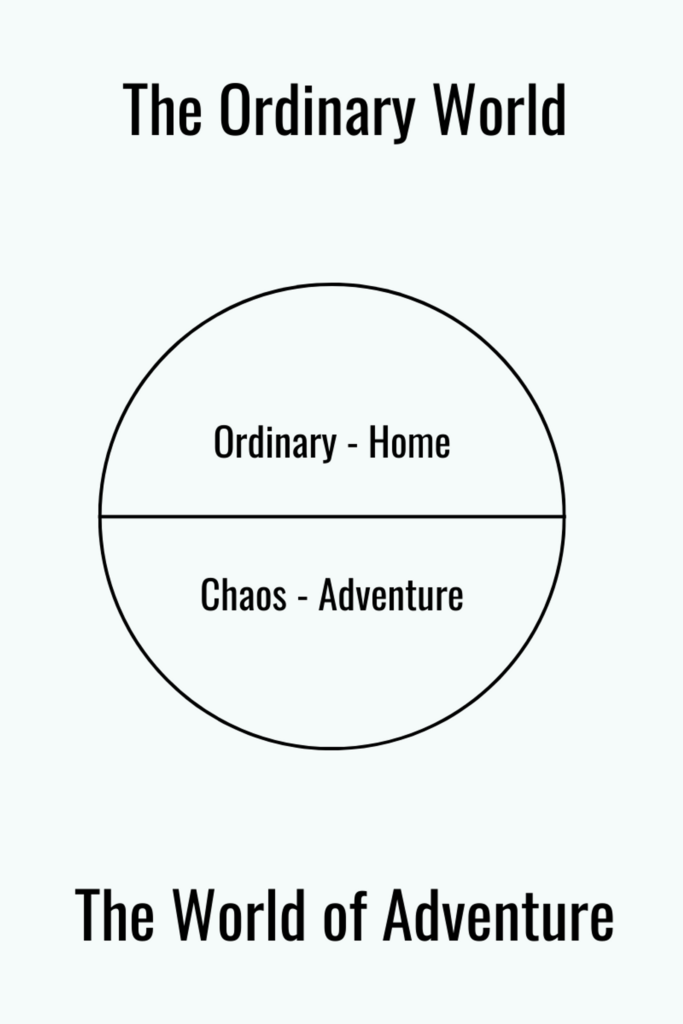
Part 2: The World of Adventure vs. The Regular World
It wouldn’t be a story if you didn’t end up in The World of Adventure.
The reason we love stories so much is that they transport us. They take us out of the everyday grind. They show us who we can become if we take a leap of faith and follow our dreams, passions, and inner guidance.
When you split your story circle in half horizontally, you see how the hero must cross the threshold, passing from the regular world into the world of adventure.
For the story to get going, the hero must enter a quagmire of challenges.
Crossing the Threshold
The character enters an unfamiliar situation.
They are now in the World of Adventure. They are no longer stuck or stagnant. They are NOT in their comfort zone any longer. They’ve stepped out onto the rickety bridge and are moving forward, one foot in front of the next, creeping over the abyss.
They adapt to the situation.
This is the part in the story where the hero meets friends and foes and gains tools and tricks that they can use to defeat their enemy in the future.
You could think of this as the training stage.
In your own life, when you embark on a new adventure, there’s a stage where you’ve landed in the new world, and you have to learn the ropes.
You start a new job, and you have no idea what the hell you’re doing.
You meet new co-workers, figure out who the crazy people are, and learn how to use the weird 1980s coffee maker they inexplicably have in the break room.
Joseph Campbell called this stage of the Hero’s Journey the Road of Trials.
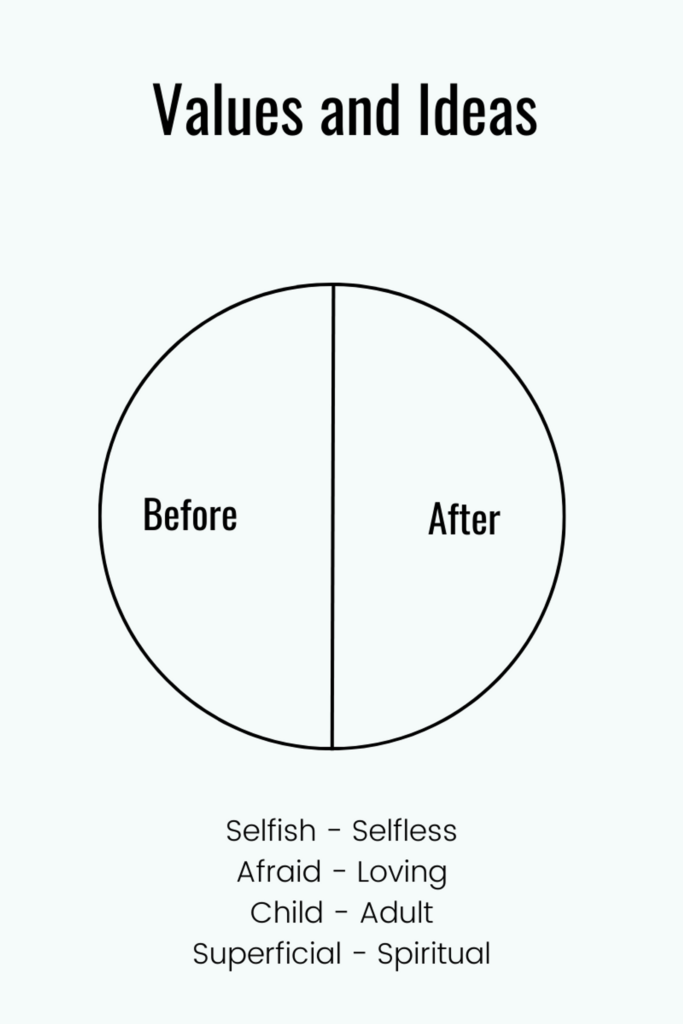
Part 3: Starting Value or Idea and Ending Value or Idea
The final part of the story circle is the vertical cut.
On the left, you have the idea or value that drives the character and the story from the beginning. On the right, you have the idea or value that takes over after the character lives through the moment of reckoning or meeting with the goddess.
If you begin the love story guarded, unwilling to trust your heart with anyone, after you experience a true-love kiss, you change.
You begin to act out of love instead of fear.
You’re no longer guarded; you’re driven by a desire to love and be loved.
If you begin a coming of age story as a selfish, bratty, spineless child, you will cross the threshold at the bottom of the story circle and move into adulthood. You are no longer in it for yourself alone; you fight for others and give of yourself selflessly.
If your story can’t be split into two opposing values, it will lack tension.
Watch: The Dan Harmon Story Circle Explained by Dan Harmon
Common Story Circle Questions:
When you’re writing a story or coming up with the plot points for a screenplay or video, it’s common to get lost or stuck.
Although storytelling is a natural part of how we share the moments in our lives with friends and family, when doing it formally, things can go sideways fast.
So, let’s answer some of your pressing story circle questions!
When should you use Dan Harmon’s story circle?
You should use Dan Harmon’s story circle and the Hero’s Journey structure whenever you’re crafting a story.
Before you start writing a story or script, create an outline of the structure and use Dan Harmon’s story circle to test your idea. Make sure that you have all the basic structural elements before you start writing.
What is a story circle?
A story circle is a way of breaking down your story’s structure to identify if your story works.
The story circle is based on Joseph Campbell’s Hero’s Journey. It is Dan Harmon’s simplified version of the hero’s journey and is a simple structural analysis tool for storytellers.
What is the concept of the story circle?
The basic concept of the story circle is that every story follows a universal pattern.
Every story starts with a main character that has a need, goes on a journey into a world of adventure and is changed through facing challenges.
How many steps are in a story circle? And what are the steps?
There are eight steps in the story circle.
- You – A main character in the ordinary world
- Need – Has a need and a desire to take action
- Go – They leave their ordinary world and take decisive action
- Search – The hero searches for what they need, facing obstacles
- Find – They find what they were looking for, but it’s not what they expected
- Take – They pay the price and face their mortality as they take what they need
- Return – Finally, the hero can return home
- Change – Transformed and ready to share their wisdom
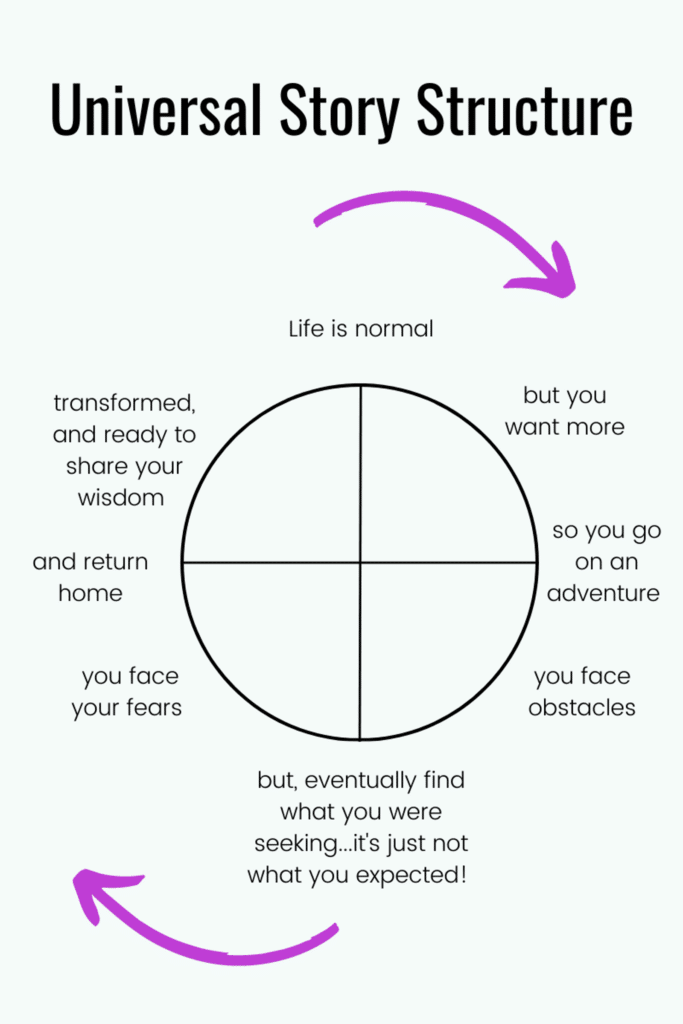
Where did the story circle come from?
The story circle came from Dan Harmon’s obsession with storytelling and his need for a simple story structure tool that could help him while writing hundreds of television episodes.
Did Dan Harmon create the story circle?
Dan Harmon created the story circle based on Joseph Campbell’s analysis of the hero’s journey.
Become a Confident Storyteller
Hi, I’m Colette Nichol! I’m a video producer, story strategist, and solo filmmaker based out of Vancouver, Canada.
If you’re interested in becoming a confident storyteller, check out my online storytelling course Story Guru.
Or read more of the storytelling articles on the blog:
📖 How to Tell a Captivating Story
📖 How to Write a Logline for a Movie

About the Author
Hi! I’m Colette Nichol. I’m a solo filmmaker and story strategist based out of rainy Vancouver, Canada. I’ve been making videos and micro films for small businesses and global brands since 2014.
Plus, I LOVE to help aspiring filmmakers pursue their dreams and start making films. This blog is designed to help you gain the knowledge you need to become a filmmaker.
If you want more, get on the waitlist for the Story Envelope Academy Solo Filmmaking Mentorship Program. It opens up one time per year and is the best way to become a filmmaking or video pro fast!
CLICK HERE to get on the solo filmmaking mentorship waitlist.